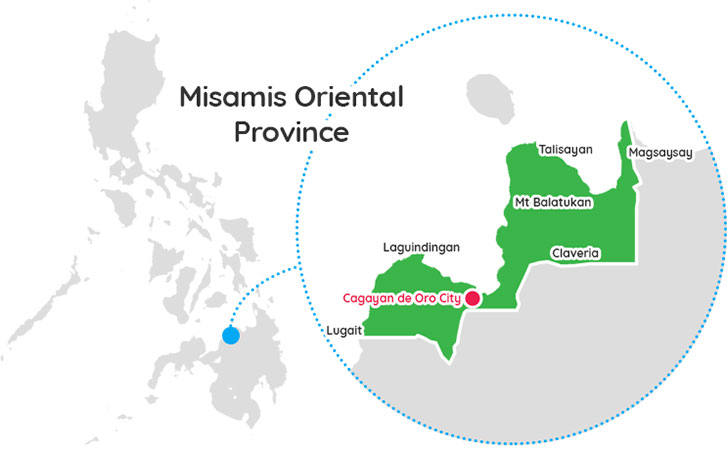About misamis oriental

Misamis Oriental, officially the Province of Misamis Oriental, is a province located in the region of Northern Mindanao in the Philippines. Its capital, largest city and provincial center is the city of Cagayan de Oro, which is governed independently from the province.
History
In the 16th century, the people of the territory were obliged to pay tribute to Maranao Muslim rulers as the regional powerhouses converted to the Muslim faith. Lumads on the coast started converting into Islam or were displaced by other ethnic groups that converted earlier. Those in the interior retained their native faiths.
Misamis Oriental shared a history with Misamis Occidental of being part of the Province of Cebu during the Spanish colonial era. In 1818, Misamis was carved out from Cebu to become a separate province with Cagayan de Misamis (Cagayan de Oro) as its capital and was further subdivided into partidos or divisions: Partido de Cagayan (Division of Cagayan), Partido de Catarman (Division of Catarman), Partido de Dapitan (Division of Dapitan), and Partido de Misamis (Division of Misamis). The new Misamis province was part of the districts of Mindanao during the later part of the 19th Century, with its territory spanning from Dapitan to the west, Gingoog to the East, and as far as Lanao and Cotabato to the south.
Misamis is one of the Spanish-controlled territories vulnerable to Moro raids. The Fuerza de la Concepcion y del Triunfo in Ozamiz was built as a Spanish military installation and one of the staging points in their expeditions against Moros. A fort in Balo-i in present-day Lanao del Norte was also constructed in 1891 on the orders of General Valeriano Weyler in its renewed campaign against the Maranaos. The Fuerza de San Miguel in Iligan was also built, serving as a muster point for Spanish forces in their campaigns in Lanao.
With the organization of the Department of Mindanao and Sulu in 1917, Misamis lost a territory covering Iligan and coastal towns along Iligan and Panguil bays to become part of the Lanao province, making the remaining western and eastern territories of Misamis isolated from each other. Highland areas south of Cagayan de Misamis down to Malaybalay area were carved out to become a sub-province of Bukidnon in 1914, then eventually a full province in 1917. Migrants from Luzon and Visayas then flocked to the area. Most of them are Ilocanos, Tagalogs and Cebuanos.
Legislative Act. No. 3537 approved on November 2, 1929, divided the province of Misamis into two due to the lack of geographic contiguity. It was not until a decade later, on November 28, 1939, that the division between Misamis Oriental and Misamis Occidental was implemented by Act. No. 3777. When Misamis Oriental separated, Don Gregorio Pelaez became its first governor.
In 1942, at the onset of World War II in the Philippines, Japanese soldiers landed in Misamis Oriental to occupy the region. Filipino and American resistance guerrillas operated in the hills and forests of Misamis Oriental and Bukidnon, and both provinces fell under the jurisdiction of the 10th Military District commanded by Col. Wendell Fertig.
The American liberation forces landed in Cagayan in May 1945, with the support of the Filipino and American guerrillas based in Opol, Gingoog, and Tagoloan clearing the beachhead of Japanese defenders for the liberation forces to land.
Members from misamis oriental
Listings in misamis oriental
More Provinces

misamis occidental
Misamis Occidental is a province located in the region of Northern Mindanao in the Philippines. Its capital is the city of Oroquieta. The province of Misamis was originally inhabited by Subanens who were an easy target by the sea pirates from Lanao. The province is named after the early settlement ...read more

mountain province
Mountain Province is a landlocked province of the Philippines in the Cordillera Administrative Region in Luzon. Its capital is Bontoc. Mountain Province was formerly referred to as Mountain in some foreign references. The name is usually shortened by locals to Mt. Province. The province is also known for its mummy ...read more








